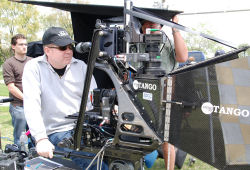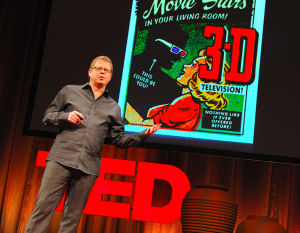Geneva Film Co. Takes 3D to the Masses
The Toronto production company, led by Director James Stewart, has been talking up 3D from TED to Cannes, with stops in between to shoot for Lexus, Sprint and others.
Geneva Film Co.'s James Stewart Takes 3D to the Masses
The director has been talking up 3D from TED to Cannes,
with stops in between to shoot for Lexus, Sprint and
others. He's getting ready for a 3D-enabled future.

When Director James Stewart decided to reposition his Toronto–based Geneva Film Co. in 2005 to shoot 3D, most people still associated the format with headache-inducing cardboard glasses or thought of it as just another passing fad. Hollywood studios were still churning out standard-issue 2D blockbusters. Nevertheless, Stewart did his research, put together a team and pushed creative storytelling into the future. And then came "Avatar," and in its wake came the first seismic shift around the creative potential of digital 3D film technology.
Fast forward to today. These days, Geneva Film Co. says it's booked solid with 3D projects, and spreading the gospel of 3D know-how to a broad swath of clients and ad creatives has become part of Stewart's regular duties. While some companies are still weighing whether or not to open a stereoscopic division, Stewart's been busy talking up the depth of this medium (no pun intended) and the depth of Geneva's knowledge base - directing 3D content one day, pitching projects the next, and opening eyes in between.
Given his upbeat presenting style and his ability to break things down for novices and pros alike, he's also become a sought-after speaker at events like TED and Cannes Lions, with repeat engagements scheduled for 2012. His takeaway from all this? "Creatives just need to learn a little about 3D to see the huge potential," he says. "Once they understand the relative simplicity and affordability, they become very keen to get outside their 2D boxes."
To encourage this, Stewart likes to point out that we humans already see everything in 3D anyway – so, essentially, when shooting in three dimensions, "we're really only transferring this innate ability to the screen via cameras with dual lenses capable of mimicking human sight," he notes.
One of his favorite ways to illustrate this fact is deceptively simple, as he explained in his talk at the Cannes Lions festival earlier this year: He'll have the audience view a spot with one eye closed – a handy equivalent of 2D. Then he has them watch the same spot again, this time with both eyes open – an instantaneous means of rendering a 3D version of the same spot. Then, the requisite show of hands: Who liked the spot better in 2D? The answer is usually nobody.

Thanks to his early-adopter status, Stewart has become a sought-after resource for all things digital 3D and has developed a reputation for effectively decoding the terminology for the uninitiated yet curious among us. Thus "negative versus positive parallax" is translated to "just a fancy way of saying 'objects fly off the screen, versus immersing viewers in the scene,'" he notes.
Stewart and Geneva Film Co. have also consulted with technology companies as they launch their newest phones, tablets, and laptops in this new dimension. "The most exciting recent advance is something called 'autostereocopic' viewing," he notes. "In other words, 3D viewing without glasses."
As well, he continues, "The future reality is said to involve easy migration of 3D content between large home-based TV screens and the ever-increasing pile of new 3D-ready tablets – to be sold and used as secondary sets." Another exciting development he says will help the technology spread is that many of these newest devices will also come equipped with 3D cameras for recording.
According to Stewart, an unprecedented batch of brand new 3D-ready screens and devices are currently on the market, including the LG Optimus tablet, the LG Thrill and HTC EVO 3D smart phones and a Toshiba laptop, to name a few. Gamers are scooping up Nintendo's glasses-free 3DS handheld, and Asus has just released a new glasses-free tablet. "Rumor has it the iPad 3 will also have 3D capability," he muses.

In terms of overall production, the last few years have seen Geneva shooting spots from Japan to L.A., in between 3D gigs for global brands like Lexus, Sprint and Lucentis and working with filmmakers like Werner Herzog on his mesmerizing documentary "Cave of Forgotten Dreams" (which was re-mastered for cinema by Geneva). Stewart is also busy producing his own 3D films, "Foxed!" and the viral hit "Beatrice Coron's Daily Battles."
In the early days of the 3D resurgence, Stewart was of the opinion that "the work companies like ours is doing will revolutionize motion pictures in all media, from film and TV to gaming and mobile. The immersive nature of 3D changes the way we tell stories." Today, he feels this revolution is in full bloom: "While broadcasters like ESPN 3D, 3net, SKY and BBC (which will unveil 3D in the UK next year) continue to grow their sphere of influence, the cross-spectrum of new 3D content noted above has evolved into a far more advanced and ubiquitous state than was anticipated a mere half decade ago.
"Once the demystification process has begun," Stewart concludes, "it's a short leap to the really fun part. Every creative who's held a 3D smartphone in their hand has said some variation of, 'Wow!' For them, the thought that their new spot or film can now be played back in 3D on someone's personal screen, which they can watch as they're headed home on the subway after work or in a park or wherever, is a truly awesome and inspiring prospect."
Published 12 December, 2011









